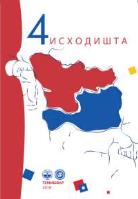СРБИ И РУМУНСКЕ КНЕЖЕВИНЕ У СВЕТЛУ ДВА ЦРКВЕНОСЛОВЕНСКА РУКОПИСА ИЗ XVII ВЕКА
THE INFLUENCE OF THE SERBS ON THE ROMANIAN PRINCIPALITIES WALLACHIA AND MOLDOVA
Author(s): Ivan BirtaSubject(s): Ethnohistory, Social history, 13th to 14th Centuries, 15th Century, 16th Century, 17th Century, 18th Century
Published by: Universitatea de Vest din Timişoara
Keywords: Baba Novac; Banat; Birta; Moghila Voivode; Walachia; Vellum parchment; Serbs;
Summary/Abstract: The subject of these work is to investigate the main characteristics of the influence of Serbs in the Romanian principals of Wallachia and Moldova between the XIV and XVIII centuries, a period marked by the massive immigration of Serbs in these regions. An analysis of Serbian migration at the end of the Middle Ages proves that Serbs already cultivated a common European concept, which was agreed and respected by Romanian authorities. This is also supported by the fact that Serbian despot Maksim Brankovitch founded the Valachian Metropolitanate and at the beginning of the 16th century brought the first metropolitan profession in Valachia. From the 15th to the 18th centuries Serbs were by far the expansion of the Romanian Banat continued to inhabit Transylvania (the area of Alba Iulia, Sibinj, Tevish and other places), and their influence remained preserved to this day. Living in to the sea of Romanian, the Serbs fought, side by side, against the Turks, for freedom and the national liberation of the Romanian territories - their new homeland. b) Old paper manuscript ”Preaching to the ancestors” (undated, presumptive date 1609). The enclosed documents are also transliterated, transcripted and translated in Serbian and Romanian language. Both manuscripts are written in ChurchSlavonic language, in the traditional unreformed civil Cyrillic (Serbian editorial version). To date, work has not been published. The text of the manuscript is amended with some individual graphemes which mark typical old phonological system. Some text оf letters are provided with acronyms. The handwriting vellum parchment (20 x 30 cm) is done with black and red ink, the scribe probably using rags or storks, if we take into consideration the finesse and the accuracy of the letters and the executed signs. The height of the letters is almost united – approx. 1 mm. The parchment, polished on both sides, is a manuscript recto and verso. The text is sprinkled with a multitude of abbreviations, typical of the drafting period of the late Middle Ages. The embossed seal of the ruler of the Walachian country, applied on the parchment, on the back, has a diameter of 16 mm, in black ink. The vellum parchment, is made of animal skin – on the basis of its distinctive quality, perhaps from unborn hides, especially processed to be suitably used. For good preservation, the parchment was covered with a thin layer of cedar or lemon oil. The second document was probably issued in the 16th century, or even in the past. The second manuscript (10 x 20 cm) is made of paper. Bothe manuscripts are part of the Romanian Carassovian funds, preserved for centuries in the “Birta Archive”, a fund containing thousands of ancient and medieval manuscripts and artifacts, part of the universal patrimony, written/ manufactured between the years 1500 before Christ –1923 a.D. The first manuscript – vellum parchment, two paged, is registered in the abovementioned fund under file number 620/1620 and 621/1844. The second manuscript, paper, four paged, are registerd under file number 300 and 301, presumptive writing year 1609.
Journal: Исходишта
- Issue Year: 4/2018
- Issue No: 4
- Page Range: 29-47
- Page Count: 19
- Language: Serbian

